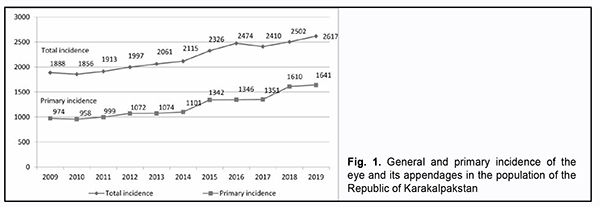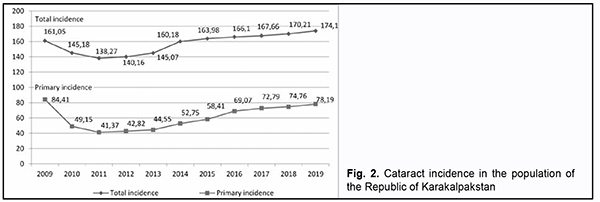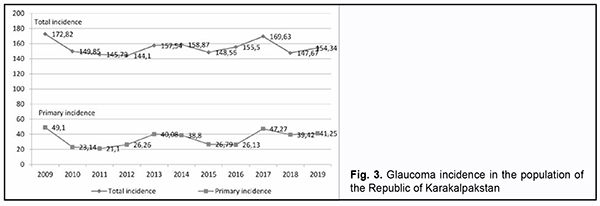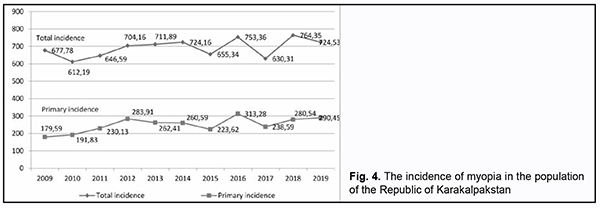J.ophthalmol.(Ukraine).2021;1:46-49.
|
http://doi.org/10.31288/oftalmolzh202114649 Received: 11 June 2020; Published on-line: 12 February 2021 Analysis of the structure of eye diseases in the population of the South Aral Sea region F. A. Bakhritdinova, Z. R. Maksudova, A. K. Matkarimov Tashkent Medical Academy; Tashkent (Uzbekistan) E-mail: akmalmatkarimov1983@gmail.com TO CITE THIS ARTICLE: Bakhritdinova FA, Maksudova ZR, Matkarimov AK. Analysis of the structure of eye diseases in the population of the South Aral Sea region. J.ophthalmol.(Ukraine).2021;1:46-9. http://doi.org/10.31288/oftalmolzh202114649 Despite the large number of works devoted to the influence of the ecological situation in the Aral Sea region on public health, insufficient attention is paid to the study of the influence of environmental factors on the organ of vision. Purpose: to analyze the detection and condition of some eye diseases in the Aral Sea population. Material and methods. The data of statistical reports of medical institutions for 2009-2019 is analyzed. Results. Over the past 11 years, among the population of the Republic of Karakalpakstan, the total and primary incidence of eyes and its appendages increased by 39% and 68.5%, respectively. The overall incidence of cataracts in the period from 2009 to 2011 tended to decrease by 16.4% (from 161.05 to 138.27), and the primary incidence by 50%. But from 2012 to 2019, these indicators have dynamically increased by 26% and 89%, respectively. The general and primary incidence with glaucoma and myopia has not had significant dynamics over the past 11 years. However, the general and primary morbidity with myopia is 1.22 and 1.36 times higher (p≥0.01), respectively, than the Republic of Uzbekistan as a whole. Conclusion. The general and primary incidence of the eyes and its appendages in the Aral Sea region has a tendency to increase every year. At the same time, the dynamics of the increase in the incidence falls on the share of patients with conjunctival diseases, myopia and cataracts. The average results of the incidence of cataracts and myopia in the Aral Sea region are significantly greater than in the Republic of Uzbekistan as a whole. Perhaps this is due to increased pollution of the atmosphere of the region and disease resistance to traditional methods of treatment and prevention of these ophthalmopathologies. Key words: Aral Sea region, eye incidence, cataract, myopia, glaucoma, ecology
Introduction Currently, the health status of the population living in the Aral Sea region should be considered in connection with the long-term effects of environmental pollution, in particular, air, soil and drinking water salts. An analysis of the dynamics of a specific non-infectious morbidity in the Aral Sea population shows that in recent years there has been a tendency to an increase in the incidence of such pathologies as cardiovascular diseases (blood vessels), the incidence of blood and blood-forming organs, the endocrine system and the genitourinary system (reproductive system). These indicators were higher than in the rest of Uzbekistan [2, 3, 5, 6, 8]. In general, despite the large number of works devoted to the influence of the ecological situation in the Aral Sea region on public health, insufficient attention is paid to the study of the influence of environmental factors on the organ of vision [4]. Anatomically, the organ of vision is open and not protected from external factors, unlike other organs of human systems. In this connection, the eyeball and the appendages of eye are target organs, the first to be exposed to adverse environmental factors. According to numerous data from world scientific literature, the climatic conditions of the area leave a definite imprint on the structure and features of the course of certain types of ocular pathology. A large amount of factual material has been accumulated on the influence of external factors on the prevalence of eye diseases in various regions of the world [1, 7, 9]. Nowadays, no deep epidemiological studies have been conducted on the prevalence of eye diseases in the Aral Sea region. In this regard, the aim of our work was: to analyze the detection and condition of some eye diseases in the Aral Sea population. Materials and methods The data of statistical reports of medical institutions for 2009-2019 presented in the Ministry of Health of the Republic of Karakalpakstan were analyzed, with the total and primary incidence calculated for 100,000 people. The study was conducted in accordance with the principles of the Helsinki Declaration. Results We analyzed the general and primary incidence of the eye and its appendages in the population of the Republic of Karakalpakstan from 2009 to 2019 (Fig. 1). Over the past 11 years, the total and primary incidence of both the eye and its appendages in the region has increased by 39% (from 1888 to 2617), 68.5% (from 974 to 1641), respectively. Moreover, the differences between the data were statistically significant according to the Student’s criterion.
As can be seen from the diagram, the general and primary morbidity of the eyes and its appendages is growing dynamically every year. At the same time, over 11 years, the average total incidence is 2196.29 it is 1.24 times less, the primary incidence of 1224.36 videlicet 1.44 times less than the Republic of Uzbekistan as a whole (the difference between the data is statistically significant, p≥0.01). We have retrospectively analyzed the dynamics of the conditions of some social eye diseases, such as cataracts, glaucoma and myopia in the Republic of Karakalpakstan for the period 2009-2019. The total incidence of cataracts in the period from 2009 to 2011 decreased by 16.4% (from 161.05 to 138.27), and during this period, the primary incidence decreased two times more than the initial one, that is from 84.41 to 41.37. From 2012 to 2019, both indicators dynamically increased by 26% and 89%, respectively (Fig. 2). Moreover, on average, the total incidence is 157.45, i.e. 1.15 times greater (p≤0.01 - not statistically significant), the primary incidence of 60.75 it is 1.27 times more (p≥0.01) than the Republic of Uzbekistan as a whole.
When analyzing data on the general and primary morbidity with glaucoma and myopia in the population of this region, it shows that these diseases do not have a significant stable increase or decrease over the past 11 years (Fig. 3 and Fig. 4). However, on average, the overall incidence with myopia is 691.33, i.e. 1.22 times greater (p≥0.01), the primary incidence of 250.45 it is 1.36 times more (p≥0.01) compared with the Republic of Uzbekistan as a whole. In addition, with glaucoma, the average morbidity data are almost similar to the data of the Republic as a whole (p≤0.01).
While analyzing the structures of primary diseases in the period 2015 - 2019, it was revealed that the first place is occupied by conjunctival diseases 48.5% (of which conjunctivitis of various etiologies 88.3%, pterygium and other dystrophic diseases of the cornea 11.6%). It is associated with the influence air pollution on the organ of vision. The second place is accommodation, refraction disorders 16.8% (of which 57.6% due to myopia), and third place is injury to the eye and its appendages 8.6%. Fourth is eyelid disease 7.2%. Fifth – lens disease 4.6% (of which complicated cataract 33%, aphakia 19.8%), glaucoma 1.9% is at the tenth place (Table 1).
Thus, the general and primary incidence of the eyes and its appendages in the Aral Sea region increases every year. In this case, the dynamics of the growth of the incidence falls on the share of patients with conjunctival disease, myopia and cataracts. The average results of the incidence of cataracts and myopia in the Aral Sea zone are significantly larger than the Republic of Uzbekistan as a whole. Perhaps this is due to increased pollution of the atmosphere of the region and disease resistance to traditional methods of treatment and prevention of ophthalmopathologies.
Bibliography 1.Amirov A. N. Influence of air pollution on the organ of vision of children. Actual problems of ophthalmology. Kazan Medical Journal. 2012; 93(6): 106-109. In Russian. 2.Archana Gupta, Akanksha Gupta. Environmental Challenges in Aral sea basin: impact on Human health. Intern. Journal of Research in Social Sciences. 2016; 6 (8): 419-440. 3.Kudaybergenova U. K., Mambetullaeva S. M. Role of ecological factors in incidence formation population of Karakalpakstan. Austrian Journal of Technical and Natural Sciences. 2014;(1):3-7. 4.Kurbanazarov M.K., Kurbanov A.B. Azhimuratova V.B., Esenbayeva D.G. The analysis of ekstraokulyar pathology at patients with short-sightedness in region of Southern Aral Sea area. Austrian Journal of Technical and Natural Sciences. 2015; 6: 76-79. In Russian. 5.Miyanova G.A. Correlation dependence of diseases of the nervous system of the Aral Sea population taking into account the level of environmental pollution. The Journal of scientific articles “Health and Education Millennium”. 2016; 18(6): 80-82. In Russian. 6.Mukasheva B.G. The impact of climate on the health status of the Aral Sea population. Occupational health and medical ecology. 2015; 4 (49): 20-30. In Russian. 7.Onischenko A.L., Kolbasko A.V., Melnichenko M.A., Filimonov S.N. Pathology of the Organs of Vision in Metallurgists. Ophthalmology in Russia. 2018; 15(4): 492–496. 8.Sakiev K.Z., Zhumabekova G.S., Batyrbekova L.S., Ibraeva A.D., Khaidarov K.K. Current health problems of the Aral Sea population. Bulletin of KazNMU. 2014; 3(3): 220-222. In Russian. 9.Wolfsan I.F., Kremkova E.V., Pechenkin I.G., Farrakhov E.G. Geological risk factors for eye diseases. Clinical Gerontology. 2006; 7: 44-46. In Russian. No conflict of interest was declared by the authors
|





